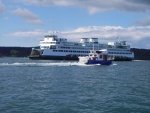hardee
New member
- Joined
- Oct 30, 2006
- Messages
- 12,637
- Reaction score
- 2
- C Dory Year
- 2005
- C Dory Model
- 22 Cruiser
- Hull Identification Number
- Brat # 2202
- Vessel Name
- Sleepy-C
Tim,
Thanks for the really great display and explanation. It looks like it is a very good tool, useful for information, techy enjoyment, and for safety. I do think it would be worth having, especially when transiting highly used commercial traffic areas in limited visibility situations. So far, I have been fairly successful in guarding my exposure to that type of incident, but I think of AIS kind of like carrying an inflated dingy or current flares and overly rated PFD's. Do I want them there? YES! Do I want to know how to use them? YES! Do I need to use them? Hope not. I am considering including AIS on board, whether it will be just a receiver or a fully active transponder may have some to do with what the admirable says, and either way it is down a ways on the boat priority list.
You are a long way ahead of me on the use of the C120, and I need to be doing some catchup there. Just need to be spending more time on the water for that. Oh, another good reason to be on the water more.
Thanks again for the neat chart displays and useful, understandable explanations.
Harvey
SleepyC :moon
Thanks for the really great display and explanation. It looks like it is a very good tool, useful for information, techy enjoyment, and for safety. I do think it would be worth having, especially when transiting highly used commercial traffic areas in limited visibility situations. So far, I have been fairly successful in guarding my exposure to that type of incident, but I think of AIS kind of like carrying an inflated dingy or current flares and overly rated PFD's. Do I want them there? YES! Do I want to know how to use them? YES! Do I need to use them? Hope not. I am considering including AIS on board, whether it will be just a receiver or a fully active transponder may have some to do with what the admirable says, and either way it is down a ways on the boat priority list.
You are a long way ahead of me on the use of the C120, and I need to be doing some catchup there. Just need to be spending more time on the water for that. Oh, another good reason to be on the water more.
Thanks again for the neat chart displays and useful, understandable explanations.
Harvey
SleepyC :moon




